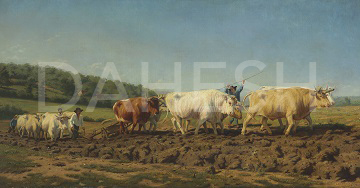When Elizabeth Jane Gardener arrived in Paris in 1864, she found the world of art largely closed to her. “I had never dreamed, on quitting America, that all Paris had not a studio nor a master who would receive me,” she later recounted. Not only were women barred from most private studios, they also could not study at the government funded École des Beaux Arts nor compete for the prestigious Prix de Rome scholarship. Despite these challenges, some women like Gardner persevered and forged professional careers as painters. By looking at Gardner and another successful female artist, Rosa Bonheur, we can see how women artists broke down the barriers holding them back throughout the 19th century.
Bonheur became one of the most acclaimed animal painters of her generation, but she was persistently hindered by doubts that she couldn’t paint as well as a man. Bonheur’s father Raymond, a drawing instructor and painter, began teaching her at 13, supplying an education Bonheur could not attain elsewhere. In 1841 she debuted at the Salon and seven years later she won a gold medal, but her greatest success came in 1853 with The Horse Fair (Metropolitan Museum of Art). This was a forceful assertion of Bonheur’s artistry, which made clear that her technique and subjects could compete with men. Horse and Rider and Grazing Sheep in the Pyrenees (ca. 1868, above, left) in the Dahesh Collection demonstrate Bonheur’s close attention to animal musculature. The accuracy and spontaneity of this work indicates her intensive plein-air practice and also hints at the lengths she went to make art—she cropped her hair and donned men’s clothing so that she could visit slaughterhouses and horse fairs to study animal anatomy.
Bonheur’s hard-won success served as a model for other aspiring women, including the American expatriate Gardner. Gardner noted with pleasure that “Rosa Bonheur must have some twenty pictures” at the 1867 Exposition Universelle, and also cut her hair short in imitation of Bonheur. Gardner most poetically expressed her admiration by copying Bonheur’s famous work, Plowing in the Nivernais (Musée d’Orsay). This copy, in the Dahesh Collection (1868, above, right), showcases Gardner’s ability to emulate other artists, a skill she later used in mimicking her husband and teacher, William Adolph Bouguereau. Gardner’s perseverance helped her to gain entrance to the elite Académie Julian in 1875, where she was the first female student, and in 1887 she became the first and only American woman to receive a medal at the Salon. By the end of the century the efforts of women such as Bonheur and Gardner paid off; in 1897 women won the right to study at the École des Beaux Arts and in 1903 they began competing for the Prix de Rome.




